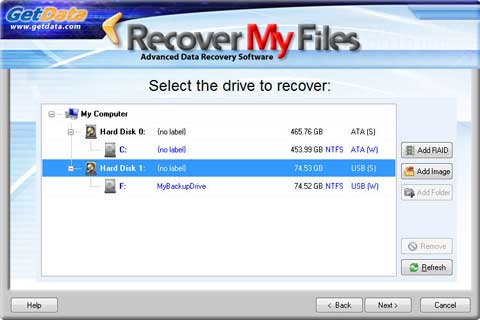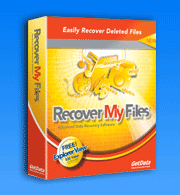Hard Disk Data Recovery Quick Start Guide
Intro. What type of search? Recover drive Recover files Preview and save results
Recover Drive
The Recover Drive search is best used when:
- a drive has been formatted;
- a drive has been formatted and windows has been reinstalled;
- a Windows recovery or system restore has resulted in a fresh installation of Windows and the previous user created files are missing;
- a drive letter has gone missing;
- the drive is recognized by your PC as RAW and no files can be read;
- or some other problem has effected the entire contents of the drive.
- It can be used for both NTFS and FAT data recovery
Click the Recover Drive button, then click the Next button.
Hard disk data recovery
The next wizard screen performs a scan to identify the hard disks, digital cameras, USB drives etc. that are connected to your computer. Select the disk that you wish to search by clicking it with you mouse.

When running a "Recover Drive" it is usually best to select and search the entire "Hard Disk".
Look for the "hard disk" which is the size of your problem drive ("Hard Disk 0" is usually where the C: drive is located, a secondary drive is "Hard Disk 1", etc).
When you perform hard disk data recovery, you are telling Recover My Files to ignore any partitions (drive letters) that are found on the disk, and treat the entire drive as a single block of data. In many cases this is the best way to undelete all possible files and get data back. (Note: by searching the physical drive, Recover My Files will also find and display existing files which have not been deleted or lost).
"Automatic drive recovery" (Recommended)
During an automatic drive recovery, common pre-selected file types (Avi, EXE, iTunes, Jpeg, Microsoft Excel and Word and Zip files) are used to assist in locating the missing file system. The aim is to recover the full file and folder structure including ALL files. Recover My Files searches for these file types by locating the header / structure and footer and then uses the information found to help pinpoint the missing file system. These files are called "Lost Files".
"Drive recovery using selected file types"
This option allows the user to manually select the file types to assist in locating the missing Filesystem.
It is suggested that you only use this option if the problem disk does not contain any of the common file types. For example, if the problem drive had only HTML files on it, it would be necessary to select the HTML file type.
In most cases the automatic mode is best and additional file type selections will NOT be required to locate the entire file and folder structure containing all files.
You may consider adding it to the list if you have a specific file type that is essential to recover. The benefit of adding a file types is that in addition to helping locate the file system, you are simultaneously searching for the Lost File type by looking for its header, structure and footer. If the file system has been destroyed and cannot be recovered, you may still find the important file as a Lost File. However, be aware that adding file types will slow down the search. We suggest that you do not select more than 10 file types at any time.
Search Phase 1 - Identifying Disk Structure
Recover My Files identifies the existing structure of the disk and the type of file system (e.g. FAT or NTFS) that is installed. This is very fast and will only take a few seconds.
Search Phase 2 - Partition Recovery
Recover My Files attempts to locate and rebuild then entire lost partitions. It does two passes down the disk. Partition recovery will take up to 15 minutes to complete (depending on the size of the drive, the number of files that it contains and the speed of the computer / drive).
Search Phase 3 - Rebuild and Display Partitions
Partitions located during phase 2 are rebuilt and displayed in the search results screen.
Whilst the search is in progress, expand the partitions (in "Folder" view using the '+' icon) to determine if your missing files have been located. Use the different views, sort, gallery, and filter options to find your files. If you find your flies and can preview them SKIP the remainder of the search and save your files.
Search Phase 4 - Searching for File System records using selected file types
Recover My Files uses the selected file types to help locate the missing filesystem records (the file and folder structure) on the drive. The number of file system records found is displayed in the progress bar. Each Filesystem Record represents a file with its full file and folder name.
If you are in a hurry to recovery your data:
When the number of "Files and Folders:" found reaches a high number (an average home computer has between 50,000 and 150,000 Filesystem records), stops increasing, and remains constant, it means the file system records located have been read. On your average home PC you should reach this point within 2 hours of searching. You can press the STOP button (note down the 'block' number that the search is up to in case you wish to recommence the search at a later time);
or, if time is not a concern to you, let the search run to the end.
Once you have stopped the search, or the search finishes, the search results will build and display in "Folder" view of the results screen as a "Recovered Partition". Expand the search results (using the '+') to determine if your missing files have been located.
To learn more about hard disk data recovery refer to the Recover Drive section of the user manual.

Recover My Files download instructions
- Click the download button to begin the download.
- If possible, save then install the Recover My Files installation program on a drive other than the one on which your files were lost.
- Run Recover My Files, search your drive and preview the files found in the results screen.
- NOTE: Software will only run on Windows PC's
» Previous Versions






